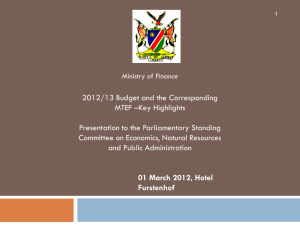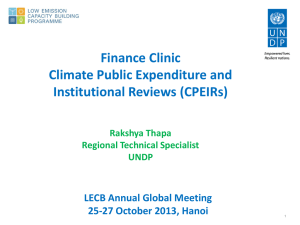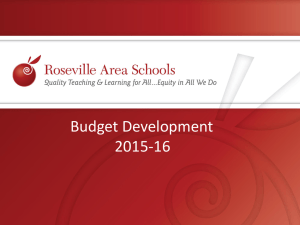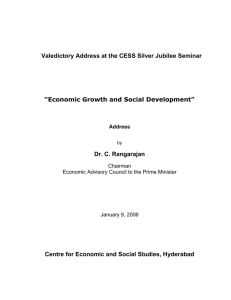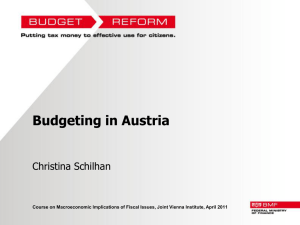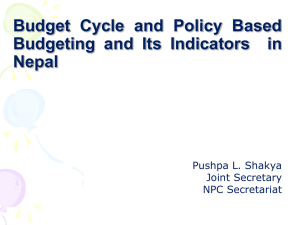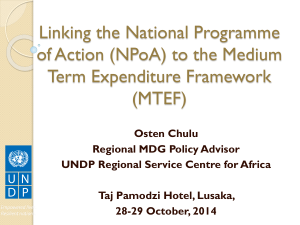view documents
advertisement
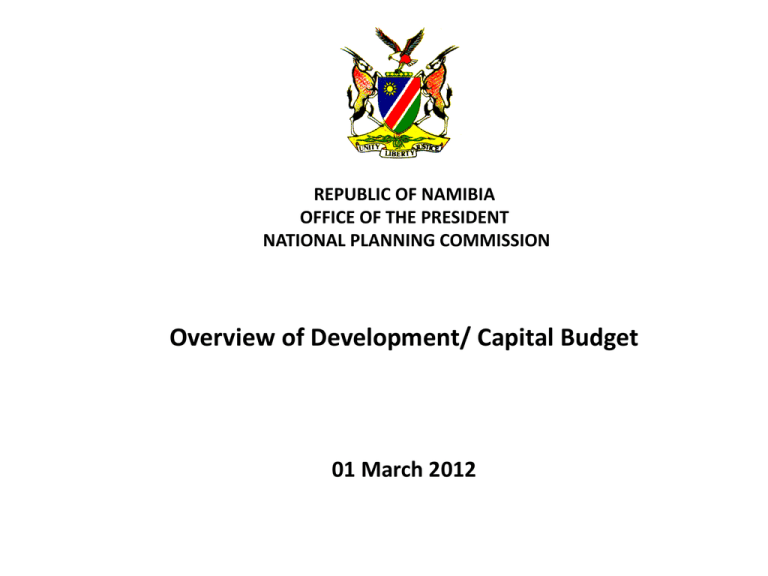
REPUBLIC OF NAMIBIA OFFICE OF THE PRESIDENT NATIONAL PLANNING COMMISSION Overview of Development/ Capital Budget 01 March 2012 Outline 1. Introduction 2. Global Ceilings for the MTEF 3. Details on Investment and Development Expenditures • Vote • Sector • Region • Programme 4. Conclusion 2 1. Introduction • The development expenditures are those allocated to development programmes in the Public Sector Investment Programme (PSIP); • These include projects on acquisition of capital assets, buildings, land, machinery, technical equipment and services of contractors/ consultants for construction and other development projects. • The Development Budget Book is divided into four parts: – Part one consists of background information on Development Budget preparation, monitoring and reporting, performance under the previous MTEF and description of allocations during the MTEF. – Part two consists of Global Summary Tables including development expenditure by vote (page 1); sector (page 2); sub-sectors (pager 3-4); Regions (page 5); and by Programme (page 6-8). – Part three is the Classification of Expenditure by Vote with details on each project (page 9-688). – Part four consists of regional expenditure by vote (page 689-750). 2. Global Ceilings for the MTEF • The Development Budget as a proportion of the National Budget is 23.3 per cent of the MTEF period. • A total number of 641 development projects will be implemented during the MTEF. • Government and donor funds allocation by financial year: Year Estimated Expenditure (N$’000) Inside State Revenue Fund in billion Outside State Revenue Fund in million Total in billions 2012/2013 6,7 453 7,2 2013/2014 7,2 258 7,4 2014/2015 7,0 175 7,2 Total 21 886 22 3. Details on Investment and Development Expenditures by Vote Top 5 votes that received high allocations (Govt and Donor funds) in 2012/13 are: Vote Transport Agriculture Health Education Reg. and Local Govt., Housing and Rural Dev. Total Allocation to All Votes (GRN+Donor) 2012/13 Allocation as % of Total Budget 21 15 12 8 7 N$7.2 bil 3. Details on Investment and Development Expenditures by Sector Percentage Allocation 100 Economic Social Administration Security 75 50 46 40 39 36 39 34 25 14 7 14 5 16 9 0 2012/13 2013/14 Financial Year 2014/15 3. Investment and Development Expenditures by Region • Throughout the 2012/13-2014/15 MTEF, five regions where the highest expenditure will take place are Khomas (19 per cent); Karas (11 per cent); Kavango (9 per cent); Ohangwena (8 per cent) and Oshana (8 per cent). • Reasons for these high estimated expenditures include: a large number of projects located in the capital city (Khomas region); huge agricultural and transport investments in Karas, Kavango and Ohangwena regions and; various infrastructure development for flood mitigation, education and health in the Oshana region. • On a per capita investment basis, the Karas Region tops the list with an average expenditure of N$9,601 per person. The least average per capita expenditure of N$1,604 would be in Ohangwena Region. 3. Investment and Development Expenditures by Region National Otjozondjupa Oshikoto Oshana Omusati Omaheke Ohangwena Kunene Khomas Kavango Karas Hardap Erongo Caprivi - 2,000 4,000 6,000 8,000 10,000 MTEF Average Per Capita Investment (N$) 3. Details on Investment and Development Expenditures by Programme Top ten programmes with highest percentage allocations (GRN+Donor) in 2012/13 are: Road construction and upgrading 12.6 Health system planning and management 7.5 Sanitation in urban, peri-urban and declared rural areas 6.1 Crop and horticultural improvement 4.7 Improving enabling environment for Private Sector Development 3.9 Strategic water supply infrastructure development 3.8 Combating of crime 3.8 Railways network development, maintenance and rehabilitation 3.5 Research and development (Defence) 3.5 Total Estimated Expenditure On All Programmes N$7.2 bil About 60 per cent of the estimated expenditure is earmarked for TIPEEG Projects. Allocation to TIPEEG Year Total Budget (Billions) Allocation to TIPEEG (Billions) 2012/2013 6,7 4,0 2013/2014 7,2 4,4 2014/2015 7,0 4,1 Total 13 21 4. Conclusion • The Development Budget provides citizens with information on the exact amount of public funds earmarked for investments aimed at boosting their livelihoods, welfare and prosperity. • It also assists the private sector to make business decisions in a more informed manner, thus reducing their risks. • A thorough reading of the document will enable easy monitoring of the utilisation of funds, and to hold those responsible for implementation accountable. 11 I THANK YOU
